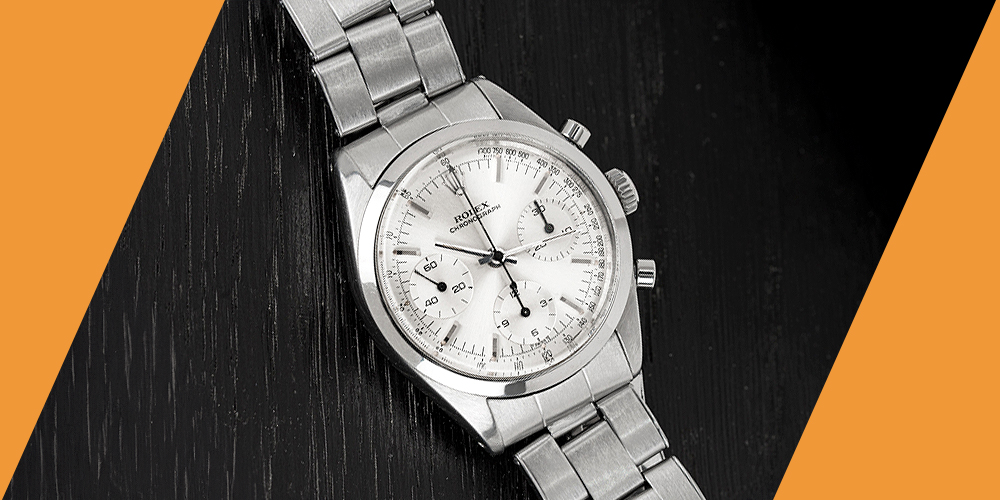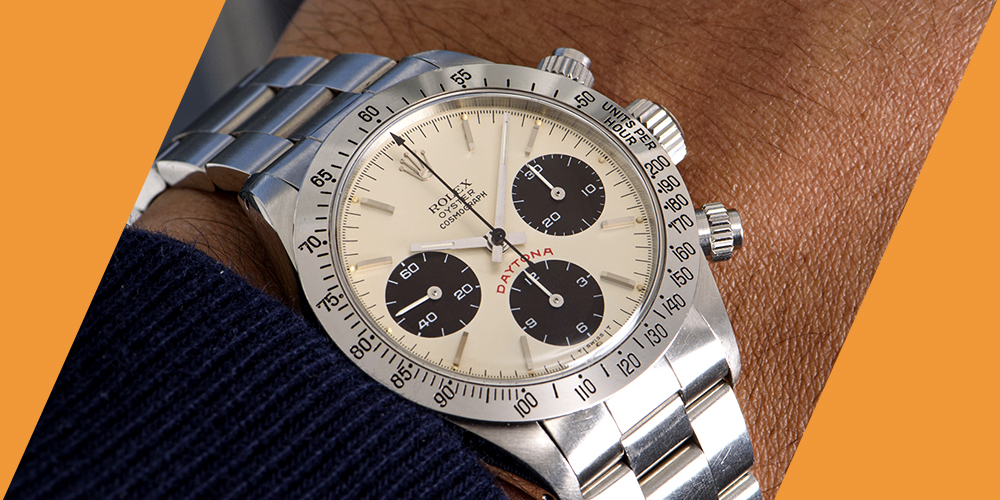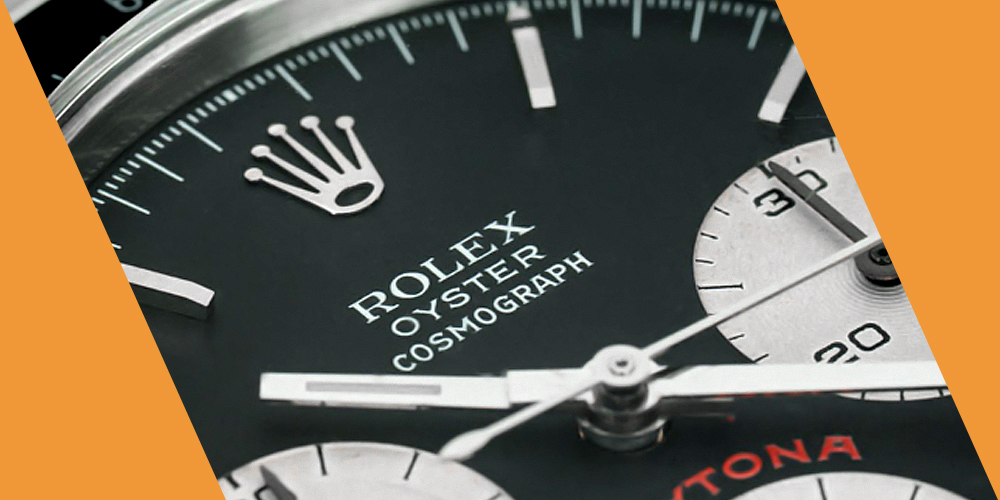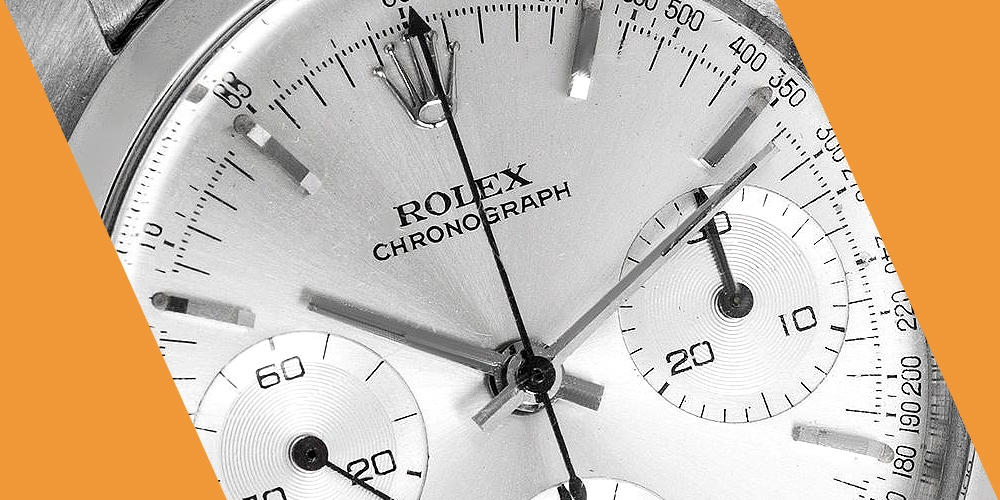
The Differences Between Each Reference

Rolex Daytona 6238 (Pre-Daytona)
Production Years: Approximately 1960 to 1967.
Features: The 6238, often referred to as the "Pre-Daytona," was a precursor to the iconic Daytona series.
It was available in steel or yellow gold. The dials came in two colours: white or black.
Uniquely, the 6238 featured the tachymetric scale not on the bezel but on the outer edge of the dial, a design element that set it apart from subsequent Daytona models. The pushers in this model were the pump style The case measured a classic 36mm in diameter, and it was paired with either an Oyster riveted bracelet or a Jubilee bracelet with folded links.
This model's understated yet elegant design made it a significant piece in the evolution towards the more famous Daytona references that followed. The Rolex Daytona 6238 symbolises the transitional phase in Rolex's chronograph design, bridging the gap between the brand's early chronographs and the more famous Daytona models that would follow.
Movement: Valjoux 72 B, later renamed 722 in 1965.
Rolex Daytona 6239 - The First Rolex Daytona
Production Years: Approximately 1963 to 1969.
Features: The Daytona 6239 was available in steel or yellow gold, featuring a diverse selection of dials. This included black dials for both metals, silver-white for the steel version, and champagne for the gold version, all with contrasting counters.
Notably, the "Paul Newman" dials were available in white and black for both metals. In the gold version, the white dials had a subtle yellowish hue. The bezel, a distinctive feature, had a tachymetric scale that either reached up to 300 km/h or was limited to 200 km/h. Initially branded as "LeMans," the "Daytona" branding appeared later, either below the "Cosmograph" inscription or around the 6 o'clock sub-dial.
Movement: Valjoux 72 (Rolex 722), a key differentiator from the previous Pre-Daytona models.
Rolex Daytona 6240
Production Years: Approximately 1965 to 1969.
Features: The 6240 represented a pivotal shift in the Daytona series, notably introducing the black acrylic bezel insert, differing from the metal bezels of previous models.
A significant advancement was the introduction of screw-down pushers, enhancing the watch's water resistance and making it the first true Oyster chronograph in the Daytona line. Primarily produced in stainless steel, the 6240 often did not include the "Daytona" inscription on its dial, distinguishing it from its predecessors. This model's design changes, particularly the screw-down pushers, increased its depth rating to 100 metres, significantly more than the 50 metres of the 6239 and Pre-Daytonas.
The Rolex Daytona 6240 stands as a pivotal model in the evolution of the Daytona series, introducing key features that would define Rolex's approach to chronograph design in subsequent years.
Movement: Valjoux 72 (Rolex 722).
Rolex Daytona 6241
Production Years: Approximately 1965 to 1969.
Features: Just like the 6239, this reference was available in stainless steel or yellow gold. A notable change in this model was the switch from a metal bezel to a bakelite one, offering a distinctive look with a clear contrast on the tachymetric scale. It continued to use pump pushers, and the dial and movement choices remained the same to its predecessors.
Movement: Valjoux 72 (Rolex 722).
Rolex Daytona 6262 & 6264
Production Years: Both models were produced from approximately 1969 to 1972.
6262 Features: This reference represented an evolution of the 6239, incorporating the upgraded Valjoux 727 movement for enhanced performance. The model retained the metal bezel, a characteristic of earlier Daytona models.
Notably, it was one of the last models (alongside the 6264) to feature pump pushers, marking the end of an era in Daytona design.
6264 Features: Shared similarities with the 6241, particularly in its aesthetic design, but with the Valjoux 727 movement. Like the 6262, it was the final model with pump pushers.
A subtle yet important distinguishing feature is the font used on the tachymetric scale, particularly noticeable at the "200" mark. The "2" on the 6264's scale is more angular and finer compared to the 6241, where it appears thicker and more squared, especially at the lower left corner of the "2". This detail offers a quick visual cue to differentiate the 6264 from the 6241, highlighting the nuances that collectors and enthusiasts appreciate in these vintage models.
Movement: Valjoux 727
Rolex Daytona 6263
Production Years: 1971 to approximately 1988.
Features: The 6263 merged the Bakelite bezel of the 6241 with the screw-down pushers introduced in the 6240. It featured a new 7.00 mm twinlock crown, enhancing the 37mm Oyster case's water resistance.
Representing the culmination of Rolex's innovations, the 6263 marked a stable and enduring design in the Daytona series.
Rolex Daytona 6265
Production Years: 1971 to approximately 1988.
Features: Introduced as a successor to the 6262, the 6265 stood out for its rich variety of dials, particularly in terms of inscriptions and details.
Notable was the "Big Red" Daytona, with a distinctive red Daytona name above the 6 o'clock counter.Gold versions featured the inscription “Superlative Chronometer Officially Certified” for the Valjoux movement.
"Paul Newman" dials were rare on the 6265, fitted only on the earliest steel production models.
Both the 6263 and 6265, with their 17-year production run, represented the culmination of Rolex's manual-wound Daytona designs, highlighting the brand's commitment to combining functional improvements with distinct aesthetic elements.
Rolex Daytona 6269 & 6270
Production Years: Specific years are not detailed, but these models represent special orders, often for Middle Eastern clients.
6269 Features: Known for its brilliant-cut diamonds and unique versions like the diamond-set bezel and pavé dial with sapphire indices.
6270 Features: One of the rarest, with only about eight known examples. Features include a baguette diamond-set bezel and a pavé dial with 240 brilliant-cut diamonds and 9 sapphires as indices.













